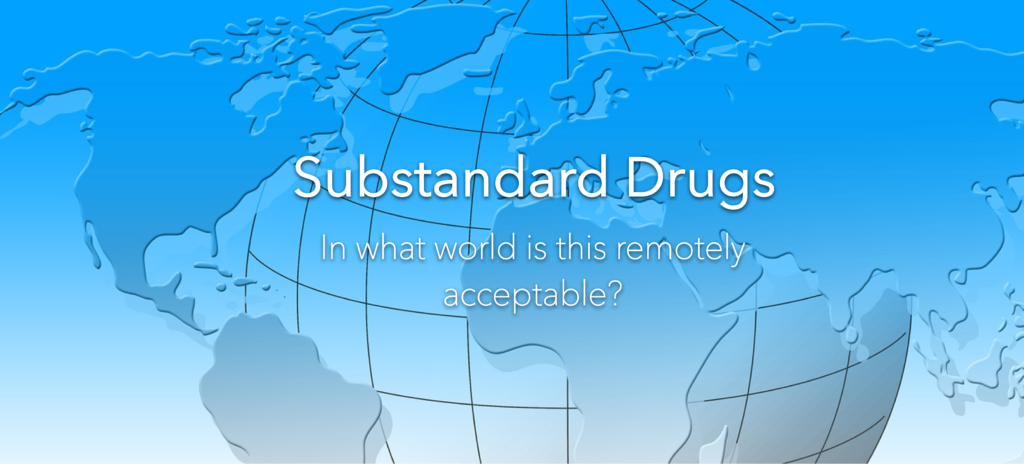From the desk of Jorge D Faccinetti Cofounder and Chairman, Pituitary World News – I recently learned that substandard drugs for acromegaly and other pituitary disorders are alleged to be making their way in some countries in Latin America. Sadly, this is not new. Research shows these substandard medications are found in all corners of the planet. Concerned citizens and patient advocates in these countries are working feverishly to keep them out, and we are ready to support their efforts. Here’s some background on the issues.
This article is meant to provide the reader with an overview of the existing knowledge base and attempts to further define the issues facing advocates around the world. The list at the end of this article includes a list of resources. In the meantime, we believe it is critical to increase awareness of these issues and provide support to organizations to better understand the problem, help to improve the regulatory control, monitoring, and advocate for increased human and material resources in the affected regions.
The World Health Organization (WHO) defines substandard drugs as “drugs that do not meet the quality specifications set for them by national standards.” In a comprehensive paper published by the British Journal of Clinical Pharmacology, Substandard drugs: a potential crisis for public health, August 2014, the authors Atholl Johnston and David W. Holt go to considerable depth to explain, define, and in general raise awareness of the consequences of poor quality drugs. Surprisingly, in spite of their poor quality, these drugs are approved by regulatory authorities. The paper, based on current relevant literature searches, makes the urgent case that an organized effort is required to make sure these drugs do not reach the market.
“Generic drugs can aid the provision of healthcare to a wide patient population, particularly in developing countries. However, generic formulations should only be marketed if their quality is equivalent to that of the originator drug. At present, to gain marketing approval, a generic drug only needs to demonstrate equivalent average pharmacokinetic properties compared with the originator drug.”
A recent WHO article states that 1 in 10 medical products available in developing countries is either substandard or outright fake. Substandard and fake medications are not the same. Substandard products are licensed and approved, but they’re of poor quality. That includes medications that expired, degraded during transportation, or contained the wrong amount of active ingredient. Falsified drugs, on the other hand, deliberately deceive people about their contents or origin and fail to treat or prevent illness. Regardless, such products can injure and kill people.
In defining these differences the WHO states:
• “Substandard also called “out of specification,” these are authorized medical products that fail to meet either their quality standards or specifications or both.
• Unregistered/unlicensed medical products that have not undergone evaluation and/or approval by the National or Regional Regulatory Authority for the market in which they are marketed/distributed or used, subject to permitted conditions under national or regional regulation and legislation.
• Falsified medical products that deliberately/fraudulently misrepresent their identity, composition, or source.” Read more about this here
Recognizing substandard medications is a challenge. A recent editorial in BMJ Journals provides a guide to identifying substandard medicines siting that they should be suspected if: a patient fails to respond to treatment; if several patients who have received the same batch of a particular drug fail to respond to treatment; if an unusual adverse drug reaction occurs. For medicines administered parenterally, unusual appearance or smell should raise suspicion that the medicine may be contaminated, etc. You can read this editorial here.
It is important to note that no country is free of these drug abuses, but they are believed to be more prevalent in low to medium-income countries. Pituitary World News is working with advocacy group members in developing countries to help understand and resolve this problem so patients in these areas are not taking drugs that may not work or are at risk to harm them. Some governments in their quest to reduce health subsidies and expenses are allowing the use of these substandard drugs.
For more information read the linked articles below:
Fake Drugs Are A Major Global Problem, WHO Reports – a comprehensive article and opinion by Rae Ellen Bichell, NPR (National Public Radio) November 2017
Substandard Medicines, Pfizer – A Pfizer position paper in support of consistent regulatory standards.
Causes of Falsified and Substandard Drugs – National Center for Biotechnology Information (NCBI) The committee recognizes that the factors that encourage the proliferation of substandard and falsified medicines are different but overlapping. In general, neglect of good manufacturing practices, both accidental and deliberate, drives the circulation of substandard drugs, while falsification of medicines has its roots in crime and corruption. …read more
Spotlight on Substandard & Counterfeit Medicines – Legitimate, quality generic medicines have nothing to do with counterfeit or substandard drugs. Confusing generic drugs with fake, substandard, or spurious medicines are dangerous. …read more
What To Do About The Deadly Threat Of Substandard Drugs – Forbes magazine (June 2014) article on the fact that historically, much attention to drugs has focused on patent battles and counterfeits in developing countries as they infringe the intellectual property (IP) rights. The most widely used definition of counterfeits by the World Health Organization emphasizes IP infringement and the intent to deceive, rather than the drug’s chemical content. …read more
Photo by Thought Catalog on Unsplash
© 2018 – 2021, Pituitary World News. All rights reserved.
